BLAM Briefing, Case study
Automated Content Supply Chain Management in the cloud. Completely in the cloud
Off the Fence (OTF), an award-winning producer and distributor of factual television and feature-length theatrical documentaries, has recently migrated their content management and fulfilment operation away from an outsourced service to an in-house, self-service model based on BLAM.
Overall, the BLAM platform provides a wide range of functions supporting the OTF content services team, however, this BLAM Briefing focuses on the automated content supply chain capability.
System Overview & Integrations
BLAM is provided to Off the Fence as a managed Platform as a Service (PaaS) from Blue Lucy.
Functionally, BLAM is the material repository for the entire OTF media inventory and provides fully automated content delivery capability. Operationally, BLAM orchestrates cloud-based services and provides precise management information through dashboards and specific reporting.
Behind the browser-based user interface, Blue Lucy uses AWS services as infrastructure to provide a cost-effective solution with infinite scalability. BLAM utilises Amazon Web Services (AWS) Relational Database Service (RDS) for database provision and the BLAM services run in Docker Containers on the AWS Elastic Container Service (ESC).
BLAM also utilises and orchestrates a number of cloud-based services from providers with whom OTF has direct commercial relationships:
- AWS S3 for all content storage;
- AWS Elemental MediaConvert for transcode / format conversion;
- Signiant Media Shuttle for content delivery;
- Telestream CloudQC for automated quality assessment;
- EasyTrack is the content rights management system. It is the master business system and is the ‘single source of truth’ component in the overall system which holds the rights and material metadata for the inventory of around 80,000 assets.
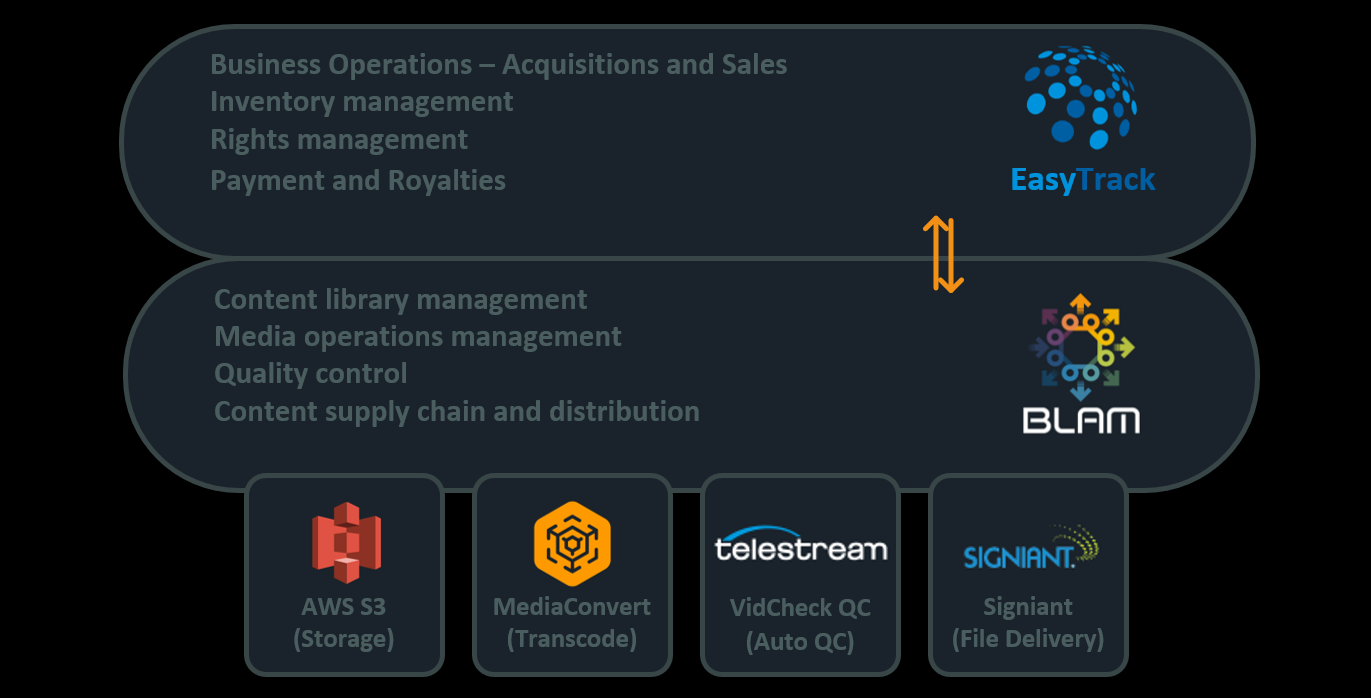
Content Migration
The OTF operating model is a great example of an increasingly popular business model in which a content owner takes direct control of inventory management and fulfilment, using technology provided on a Platform as a Service (PaaS) basis.
Typically, the biggest perceived difficulties in the migration of a significant media catalogue to the cloud (in this case more than a petabyte) is how long it will take and how much it will cost. This is a misperception though, AWS make the migration process extremely easy with their Snowball Service, as we’ve discussed in a previous posts. Using Snowballs means material arrives in the S3 Bucket in bulk – about 3,000 files per batch – with each file triggering a set of linked ingest workflows:
- Automated format validation;
- Automated browse/proxy creation;
- Automated matching of received media files to BLAM Placeholders – EasyTrack Products are mapped to BLAM Asset placeholders and keyed using the expected file name data;
- Manual Task flows for operators to quickly confirm that the file essence matches the Asset or to manually match.
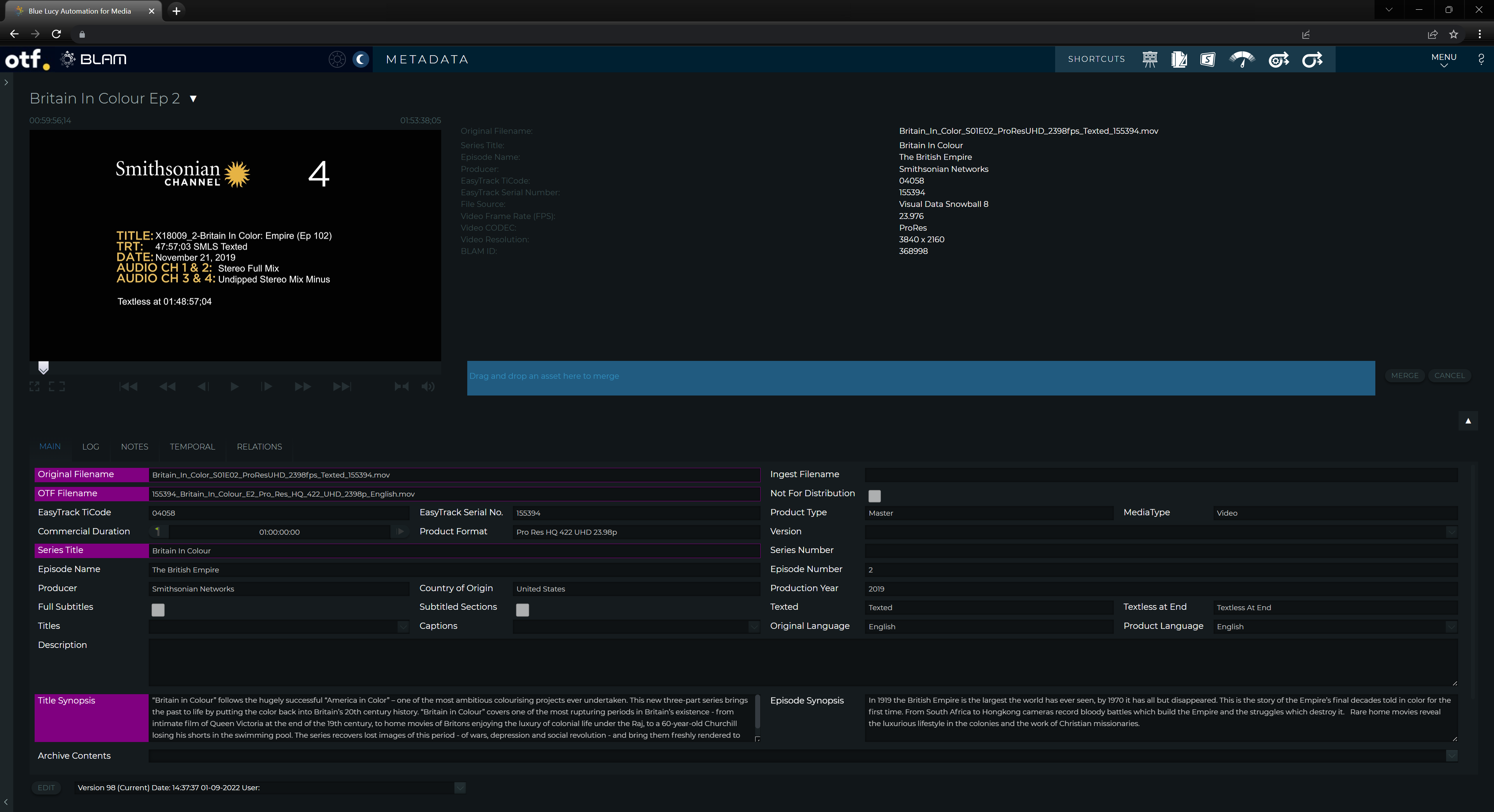
Process Automation & BLAM WorkOrders
Whilst there is a high degree of workflow-based automation during ingest, the fulfilment function is entirely automated using BLAM WorkOrders. WorkOrders create a relationship between individual workflows, allowing synchronisation, aggregation, and monitoring of complex or multi-faceted functions. Efficient operating models utilise parallel running workflows and the workflow components may not always be sequential; WorkOrders provide a mechanism for orchestrating these composite workflows.

The WorkOrder model is configurable in BLAM and allows a menu of Services to be created which are mapped to one or more automated or task based Workflows. WorkOrders may be raised within the BLAM user interface or passed in from third-party systems via the API. The WorkOrder itself will typically relate to media assets and call the Services from the menu that are required to deliver the required outcomes.
BLAM WorkOrders and OTF Content Supply Chain
In the OTF operating model all work orders originate in EasyTrack, with the scope ranging from content Quality Control (QC) to customer fulfilment (content delivery).
An EasyTrack work order is a standardised set of outcomes-based instructions held in an electronic format. Running on a schedule, BLAM gets new work orders from the EasyTrack API and processes these by mapping the instructions from the EasyTrack work order to the BLAM WorkOrder Services model. BLAM Workflows may be set to collect new work orders in this way or upstream systems may post work orders directly to the BLAM API. The work order is then processed as follows:
- An EasyTrack customer delivery work order (which makes up the majority) would typically comprise a list of Asset IDs and the required Services such as Format Conversion and Delivery.
- On receipt, the WorkOrder is validated and checked for feasibility: principally can the order be fulfilled as instructed – is the asset under BLAM management and are other parameters correct?
- An email is sent to the originator of the work order as acknowledgement that it will be processed or, if it cannot be fulfilled, notification that it has been rejected. Details of the reason for rejection are included in the notification so it can be corrected, and the work order resubmitted from EasyTrack.
- Following validation, the WorkOrder is processed and the BLAM Workflows triggered on a per asset basis in the sequence required – i.e. each deliverable asset referenced in the WorkOrder is individually processed. A typical delivery to a broadcaster will be for a Title Series which comprises a number of episodes.Example view of BLAM WorkOrders at OTF. In this case the Services follow a sequence.

Conversion / Transcode
Whilst an increasing amount of OTF content is originated in UHD and 4K, the company doesn’t have a single “house” format, so master material is stored in a variety of formats, framerates, CODECs and resolutions. The customer delivery format is stipulated in the WorkOrder and, if this differs from the mastered format in the library, a transcode workflow, using AWS Elemental MediaConvert, is invoked. Otherwise the transcode workflow is omitted and replaced with a ‘straight copy’ action.
Delivery
The delivery method is also defined in the WorkOrder and is based on the customer-specific requirement. It may be via FTP, Signiant Media Shuttle, Aspera or an S3 bucket-to-bucket transfer. Notifications are sent to both the customer and originator when the delivery has been fulfilled.
Reconciliation & Reporting
The costs of the fulfilment process (including costs for restoring assets from the archive and, if required, format conversion) are tracked against the asset and the WorkOrder. The final step in the process is for an OTF media services operator to add in costs which are external to BLAM and then generate the delivery report, known as a Job Statement, for finance reconciliation and billing.
WorkOrder Status
The WorkOrder capability has its own dashboard which supports filtering and search allowing managers to quickly see the status of all current and completed orders. For operators with sufficient authorisation, the dashboard allows WorkOrders to be modified, paused or stopped and started.
The summary view at the top of the screen shows the high-level overview of all WorkOrders. This includes the EasyTrack work order number, the customer name, start and finish dates, total cost, and overall job status. The lower section shows the breakdown which is typically the product titles – one for each episode.
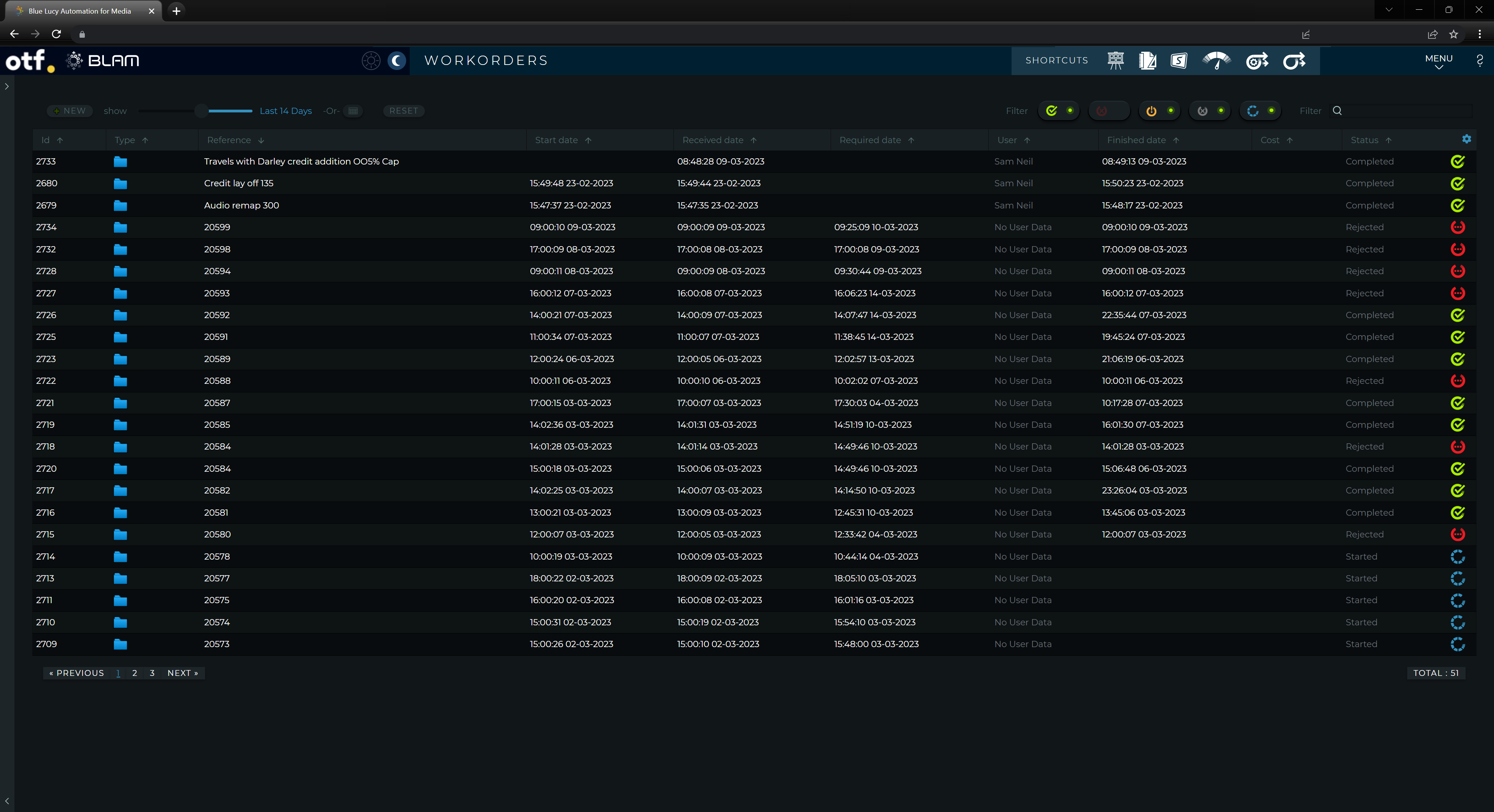
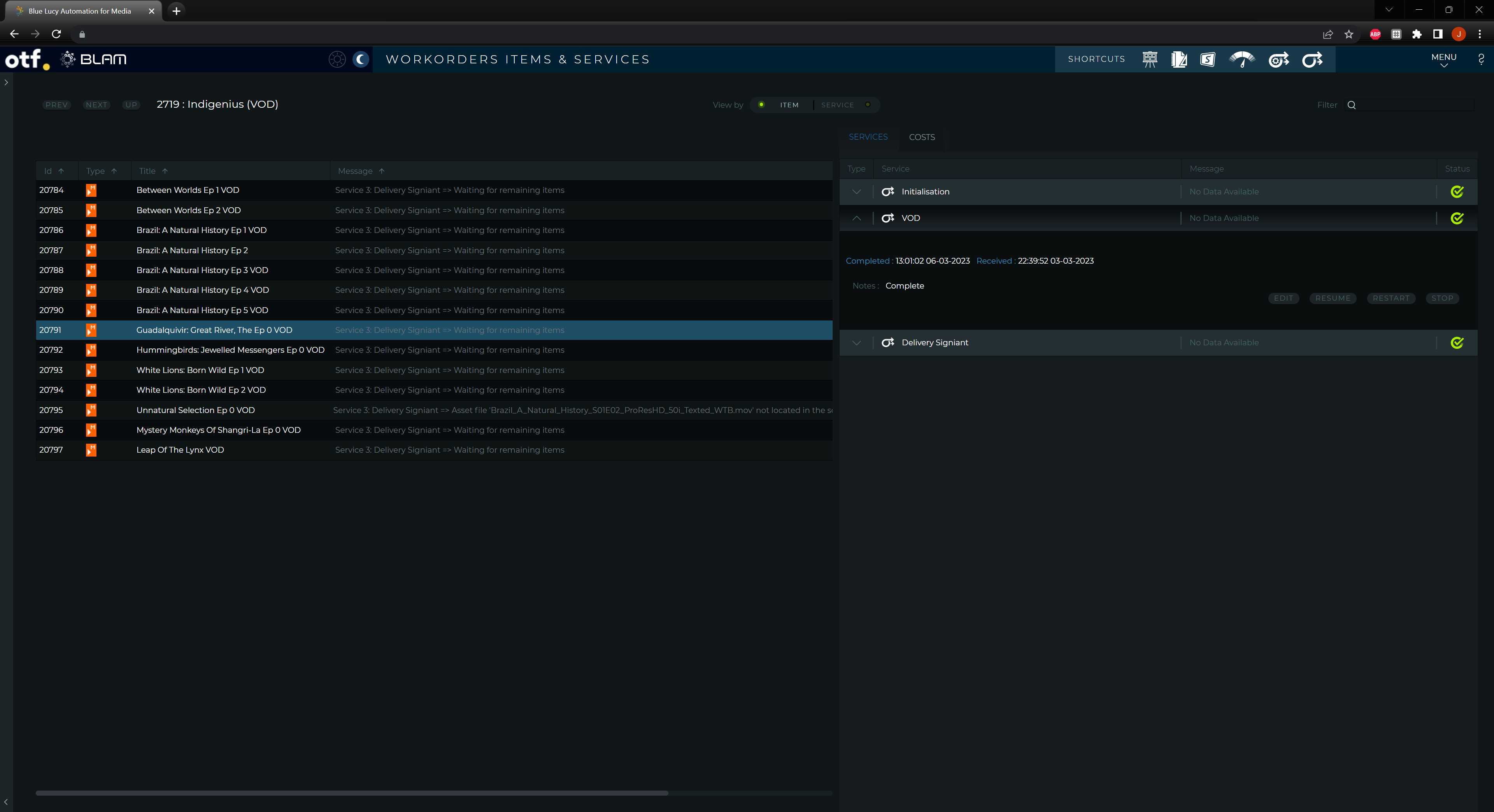
Editing WorkOrders
BLAM allows for the detail of WorkOrders to be viewed and modified if required, meaning that minor errors can be corrected within BLAM rather than requiring resubmission from EasyTrack.
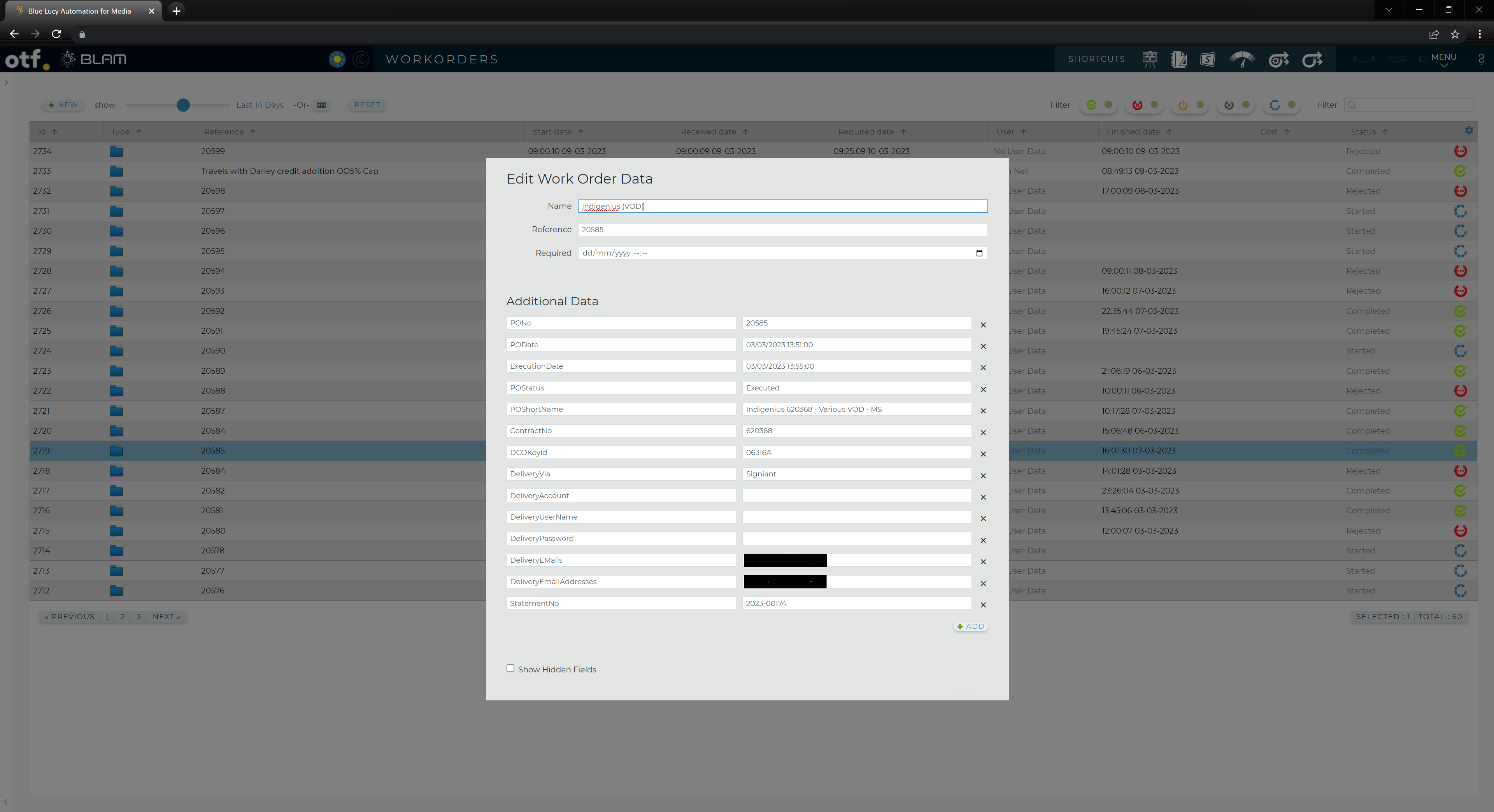
Additional Monitoring
High level monitoring for data such as delivery throughput is available in the main BLAM Dashboard. The dashboard view in BLAM is configurable based on business needs. Here OTF operational managers can see a summary of the overall movement of content – ingest and delivery, a breakdown per customer of all deliveries as well as the cost of fulfilment.

At a lower level, WorkOrder Services are mapped to Workflows and these may be monitored on a per asset, per workflow basis.
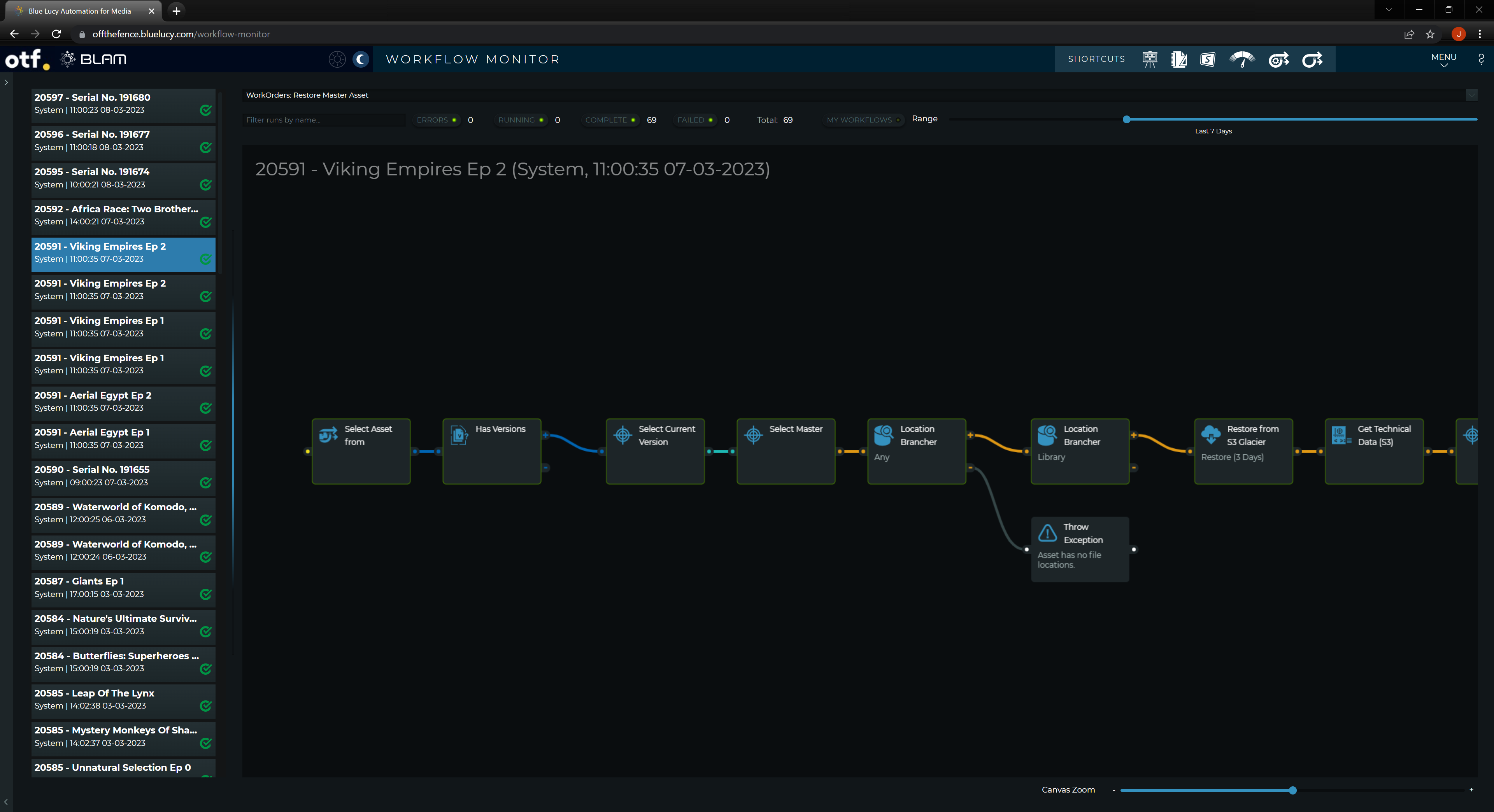
Summary
Off the Fence’s content supply chain business demonstrates how complex media operating models can be serviced and managed in BLAM using the WorkOrder function. WorkOrders allow a set of separate but dependant processes to be aggregated to deliver a specific set of outcomes through fully automated processes. The WorkOrder capability also provides real-time management information and precise reporting, enabling operators to closely monitor business functions and associated costs.
Most importantly WorkOrders, and the Workflows that underpin them, are entirely configurable in BLAM, meaning that they can be easily created and updated by a system administrator. BLAM users can truly take control of their operation without suffocating in service change requests or getting bogged down in a development backlog.
Read the BLAM In Action article for a business perspective of the solution or get in touch to find out more.
Cloud photo by Lawrence Hookham
By Julian Wright
Share this story
Share on X Share on Linkedin Share via email